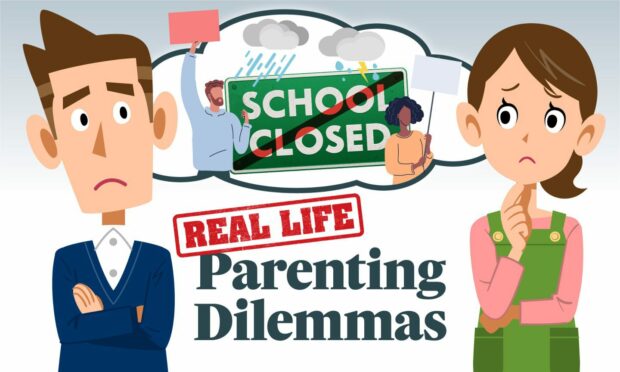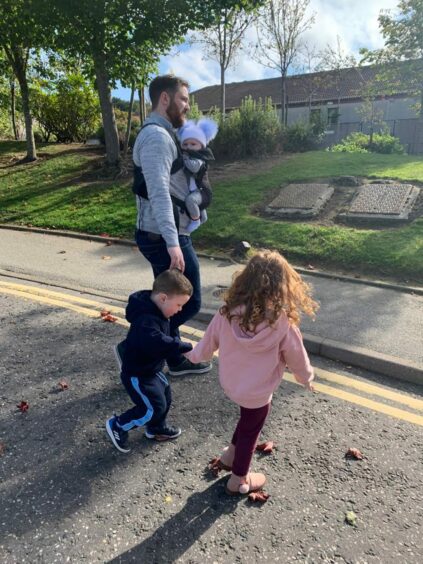Teacher strikes have shut schools twice already this year, and parents need to be ready for more unexpected school closures with strikes and bad weather headed for the region.
It may feel like dire straits when school is closed but your work isn’t.
And childcare isn’t a one-size-fits-all system. Kenny Forsyth, CEO of Stramash Outdoor Nurseries, has childcare settings in Inverness, Elgin, Fort William and Oban.
He said that relationships need to be the first consideration when making any childcare arrangement.
“Short-term choices for parents are extremely limited,” he said. “Fundamentally the child is always at the heart of the equation. Good care is about established relationships.
“So just dropping a child off at nursery for a day with no pre-established relationships and then disappearing the next day, is usually not in their best interest.”
And, as parents know all too well, the nursery is probably already full to begin with. But that doesn’t mean there are no options available.
Whether it means having a conversation with your employer or working out a deal with your colleagues, partner or fellow parents, there are a few stones to turn over before giving up.
The office isn’t what it used to be
Workplaces have changed a lot since the Covid-19 pandemic sent most of us home for the better part of two years. You may not be aware of all of the changes at your work or the new resources your employer has to offer.
If you’re in a childcare bind, immediately check with your boss or manager. Go to whoever you have a good relationship with, or check in with someone in human resources, who is sure to know the ins and outs of company policy.
There may be some leeway to work from home, work flexible hours for one day, or even bring your child with you into the office.
The latter option will obviously depend largely on the type of work you do. No children on the construction site, after all. But one Aberdeen restauranteur took his daughter to work with him while the primary school was closed this week, and the move received widespread support.
As one customer commented: “It’s so difficult running a business and being parents.
“You feel guilty taking them to work but we don’t have a choice so like you we try and get them involved. Well done.”
It may be that customers, employers and colleagues are more understanding than you expect them to be. So talk about it first and make sure you know what options are available.
Care-pool not carpool
If there’s no way to take your child into the workplace with you, and no option to work at home, you may not have a choice other than to take leave when school is closed.
But you can still minimise the disruption and inconvenience here with some foresight. Talk to your partner and other parents at your school or in your neighbourhood and see if you can arrange some joint care or play days.
If there are a few families with children around the same age, it may be that only one parent or set of parents needs to take the day off in order to watch kids while the others go off to work.
Aberdeenshire dad Ruari Collinson spoke to The Press & Journal about how he and his wife, Laura, find ways to balance their career and family responsibilities. With three young children and two jobs, he said it’s difficult to find time for work, childcare, or just plain quality time with the kids.
But he and his wife are able to work together on solutions.
Ruari’s work allows him more flexibility than Laura’s, so when emergencies come up he’s often able to make adjustments.
But he said it’s important to make sure that you discuss these plans and arrangements with your partner, or any fellow parents or family members who are helping out with childcare.
No one should feel like their work isn’t as important, he said, and don’t forget that getting to spend time with the kids is a perk in itself.
Time to rethink the system?
A quick look at how regularly parents struggled to find adequate childcare suggests that the education system isn’t designed with working parents’ best interests in mind, according to local childcare expert Kenny Forsyth.
In fact, it may not even be what’s best for the children themselves.
Depending on where you live, a nursery or childcare provider may not be an option even in normal times.
During the Covid-19 pandemic, we reported on childcare shortages across the north and north-east. Rural areas, where sometimes there is just one childcare provider to cover multiple villages, feel the strain the most.
Mr Forsyth said that, even in the best of times, most childcare centres and school wraparound programmes only have room for about 10% of the children in an area.
That means that even when schools are open and everything seems normal, there’s going to be a scarcity. And rigid term times mean that every year when October, December, April and June come around, working parents are left to find a childcare solution.
“You have primary school children who are suddenly going from one relative to another and then to outside care, with a parent who is piecing together a patchwork of arrangements to get through summer until term time starts again.
“It’s just a poor, poor system because what it is not doing is understanding the child’s need for continuity of relationships.”
Read more from the Schools and Family team
Should I post photos of my kids online?
My child was born in winter – when should they start school?
Am I taking advantage of Granny and Grandad for ‘free childcare’?

